Contents
Let us help you choose the ideal design: Vertical Vs Horizontal Rowing Tanks
When you buy through links on our website, we may earn a small commission at no cost to you. Thanks for your support 🙂
You’ll notice a lot of significant differences if you compare the rowing machine models on the market today to those offered 15 or even 10 years ago.
New models are equipped with better ergonomics, digital screens that can be connected to smartphones, and numerous other changes that have been made largely in response to user feedback and complaints.
One of the most recent modifications involves rower tanks. Initially, rower tanks were in a horizontal position, but many modern models now come with vertical or even angled tanks.
So, why do some brands use angled or vertical tanks while other manufacturers stick with horizontal rowing tanks?
Rowing tank options
There are three main rowing machine tank configurations:
- Horizontal tanks: This is the traditional rowing machine tank setup. It can be found on models such as the Sunny Obsidian Surge and the WaterRower Classic. It mimics the natural rowing motion, making it feel as if you are actually on a canoe or boat.
- Angled tanks: These tanks are angled at 45 degrees or 60 degrees. The design is intended to increase the level of difficulty or resistance to the rowing motion.
- Vertical tanks: Despite being a less common rowing tank configuration, the vertical tank is ideal for increasing the intensity of your workouts. A vertical rowing machine tank is mounted at a 90-degree angle to the rowing machine and can be found in models such as the First Degree Fitness E520.
A horizontal rowing tank has been the classic design for rowing machines. The oldest rowing machine models on the market feature this configuration, but in newer models, the angle is adjusted due to recent innovations.
What is rowing resistance?
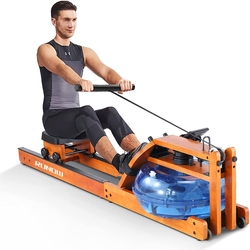 Horizontal rowing tanks offer the most natural feel.
Horizontal rowing tanks offer the most natural feel.
Boats and canoes move because the rowers and their oars transfer momentum to the water in order to propel the boat forward.
The oar imparts momentum to the water, which causes the boat to accelerate in the opposite direction. In order to maintain momentum, the blade moves the water in the opposite direction of the boat’s motion.
Blades have a large surface area to optimize the amount of water displaced since it is more energy efficient to move a large volume of water slowly than a smaller amount quickly.
Theoretically, if your blades were larger, you could row faster because they could displace more water.
The more blades installed inside the rowing machine tank, the more water is displaced, and the faster the rowing momentum.
What is the main difference between water rowers with vertical or horizontal tanks?
The main difference is in the orientation of the water tank. In a water rower with a horizontal tank, the tank is positioned parallel to the ground, while in a water rower with a vertical tank, the tank is positioned perpendicular to the ground.
This difference in orientation can affect the feel of the rowing motion and the amount of resistance provided by the water. Water rowers with horizontal tanks tend to have a smoother and more consistent rowing motion, as the water in the tank is spread out horizontally and provides more uniform resistance throughout the stroke. The motion of a horizontal tank mimics the motion of rowing a canoe or boat.
Water rowers with vertical tanks, on the other hand, may have a slightly different feel, as the water is pulled up and down in the tank during the rowing motion. Greater resistance requires greater effort or exertion to keep moving forward.
Ultimately, the choice between a water rower with a horizontal or vertical tank may just come down to personal preference. Both types of machines can provide a great workout and a very realistic rowing experience.
Best all-round strength training machine for 2023!
Additional resistance in rowing tanks that are vertical or angled
Many people use the phrase “like pushing water uphill” when describing something really difficult. There is a valid reason behind it: gravity affects water, just like everything else.
The path of least resistance is downward. Making water flow upward requires overcoming both gravity and the inherent viscosity of the water.
It’s very straightforward: rowing in a vertical or angled rowing tank is more challenging due to the effects of gravity. Therefore, in a horizontal rowing tank, in addition to moving the water, you must also push against the water’s inherent thickness.
Gravity also plays a part when rowing in an angled tank. The steeper the slanted slope, the more gravity pulls water against the paddles you’re spinning.
In a vertical tank, you must battle both the direct downward force of gravity and the viscosity of the water. This is undoubtedly beneficial for people who want to optimize their training sessions.
| PRODUCT PREVIEW | NAME | REVIEWS | Check PRICE |
|---|---|---|---|
 | RUNOW Water Rowing Machine | 332 Customer Ratings | |
 | LIT Strength Machine | ||
 | SNODE Water Rowing Machine | 566 Customer Ratings | |
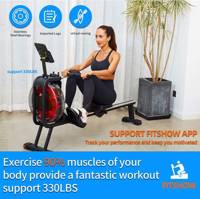 | ETONSUNNY Water Rower with Vertical Tank | ||
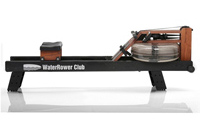 | WaterRower Club Rowing Machine | 28 Customer Ratings |
Does a vertical tank save space?
Vertical rowing tanks can be very compact.
For instance, the E520A Fluid Rowing Machine with its vertical tank measures 75.98 x 32.2 x 40 inches (L x W x H).
Compare those measurements with the Sunny Phantom Hydro SF RW5910 angled rowing machine’s dimensions: 81.5″ x 21.25″ x 39.5″ (L x W x H).
Finally, compare its measurements to the WaterRower Classic horizontal tank’s length, which is roughly 83″.
While the models’ heights are comparable, there is a significant difference in their lengths. In fact, the E520A Rower is 5.5″ and 7″ shorter than the Sunny Hydro and WaterRower, respectively.
Check out our suggestions for the best rowing machines for smaller spaces here!
What causes the difference in length?
The difference in length is largely due to the position of the tank in relation to the rails.
The water tank is usually located at the front end of the machine, whether it’s an angled or horizontal tank. However, the design is a little different for a vertical tank. Actually, the tank may be raised so that it doesn’t obstruct the rowing track. The footrests could even be positioned directly next to the tank, which would be much closer.
As a result, there is a little bit more flexibility in terms of length. For instance, the First Degree Fitness E520A is a visibly shorter machine because the tank is actually mounted on a separate stand close to the pedals.
Taking the above dimensions into consideration, you will notice that the vertical tank rower is significantly wider compared to the angled tank rower. The designers opted for a shorter but wider rowing machine.
So another important factor you may want to consider is whether you want a shorter or wider rowing machine.
The bottom line
Now that we understand the key differences between a horizontal and a vertical rowing tank, you can decide which one best suits your needs and fitness goals.
Remember that a horizontal rowing tank is all most people need. For decades, seasoned rowers have used horizontal tanks while still getting an excellent workout. However, this is something you should consider if you are deciding which configuration to buy right now.


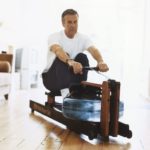
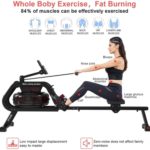


Pingback:Want a Cheap Water Rowing Machine? | Rowing Machine Pros